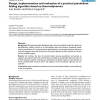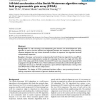243 search results - page 12 / 49 » Application of Evolutionary Algorithms to Protein Folding Pr... |
BMCBI
2004
13 years 7 months ago
2004
Background: The general problem of RNA secondary structure prediction under the widely used thermodynamic model is known to be NP-complete when the structures considered include a...
CCE
2008
13 years 8 months ago
2008
Protein structure determination and prediction has been a focal research subject in life sciences due to the importance of protein structure in understanding the biological and ch...
ISMB
2000
13 years 9 months ago
2000
Knowing the number of residue contacts in a protein is crucial for deriving constraints useful in modeling protein folding, protein structure, and/or scoring remote homology searc...
BMCBI
2005
13 years 7 months ago
2005
Background: Predicting the subcellular localization of proteins is important for determining the function of proteins. Previous works focused on predicting protein localization in...
BMCBI
2007
13 years 8 months ago
2007
Background: To infer homology and subsequently gene function, the Smith-Waterman (SW) algorithm is used to find the optimal local alignment between two sequences. When searching s...


